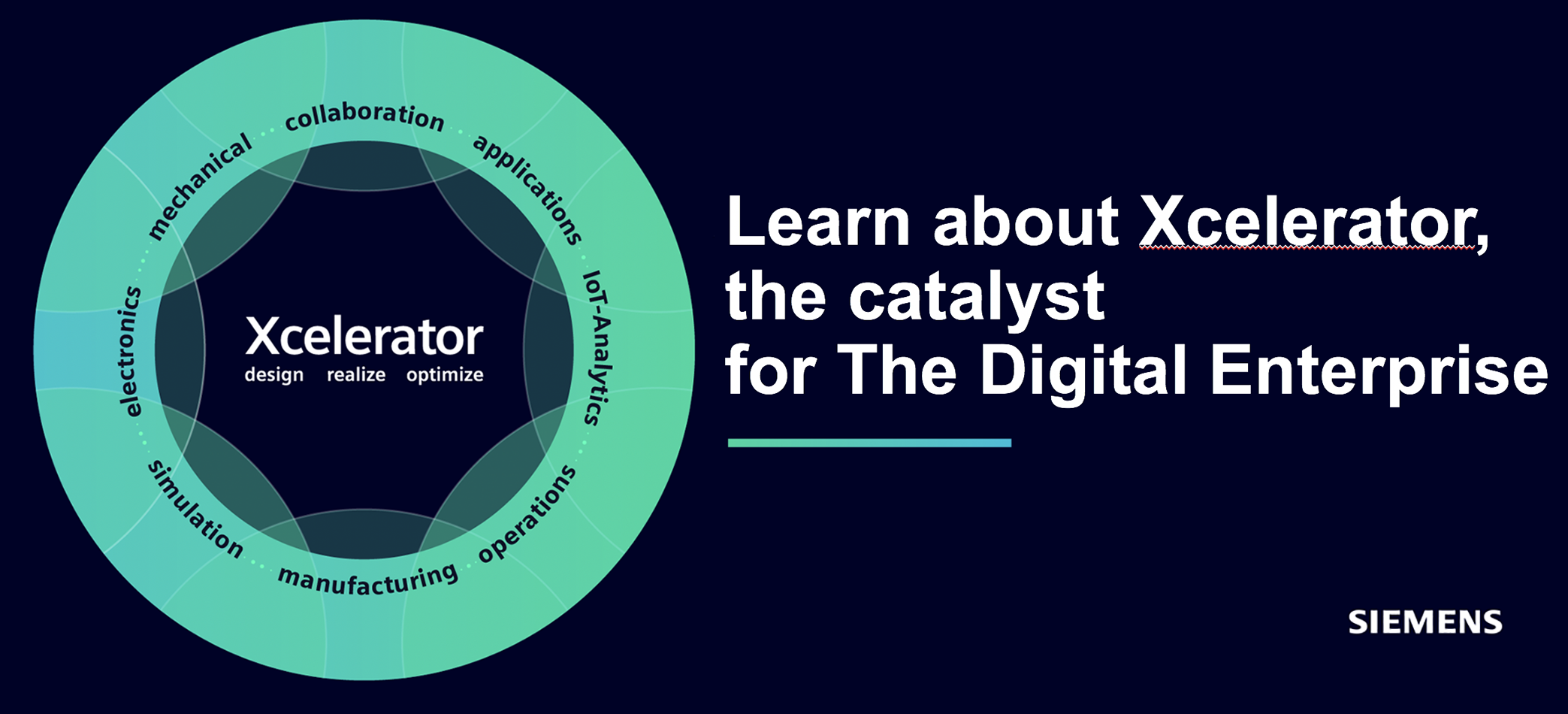First, a general look at the methodology in the analyst Frost & Sullivan’s “Frost Radar CAD, 2025”.
In the study, Frost & Sullivan has analyzed a total of more than 35 companies in the MCAD market. Of these, 9 companies and their solutions have been selected for further analysis based on their leadership and in this “benchmarked” across 10 growth and innovation criteria. After this, the software developers have been placed in positions corresponding to the results in FrostRadar’s graphical model. For copyrights reasons, we cannot show the model.
The companies featured are (in alphabetical order): Alibre, LLC, Autodesk, Dassault Systèmes, IronCAD, Kubotek Kosmos, PTC, Shapr3D and Siemens Digital Industries Software.
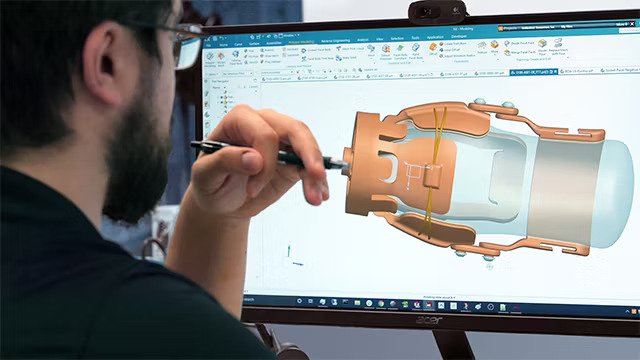
Siemens CAD solutions – a background
Overall, Siemens NX and Solid Edge end up in a combined evaluation as leading solutions in terms of innovation in the “Frost Radar: Mechanical Computer-aided Design, 2025 report”. The report states, among other things, that Siemens NX/Solid Edge has achieved the top score in the innovation index and performed well in the growth index, even if it does not top in terms of the growth position. Some of the company’s unique features include, according to the evaluation, “the many add-ons available to extend the capabilities of NX; the flexibility of licensing and Siemens’ electronics design strength, which enables seamless MCAD-ECAD collaboration.”
In general and as a brief background, notably both NX and Solid Edge have a strong and growing presence in the cloud, with approximately 25% as SaaS (Software-as-a-Service) installations. What these SaaS and cloud versions of Siemens CAD software have in common is that they have the suffix “X” after their name. This in turn means that they are Xcelerator-as-a-Service solutions, with the cloud as the technical platform and SaaS as the business model.

According to Joe Bohman (left), EVP and Siemens global head of the PLM solution Teamcenter, the Xcelerator-as-a-Service portfolio means that the powerful functions of the company’s rich software portfolio are now brought together through purpose-built technology and service experiences that are, “tailored to the requirements of industries and individual users.”
This expansion of the cloud service portfolio has since its announcement during the Siemens Realize Live event in Las Vegas last year, been loaded with, among other things, NX-X, a new app for manufacturing and shop floor, Zel X, the MOM and MES software Opcenter X, the simulation and analysis platform, Simcenter X, and Teamcenter X Essentials (PDM).
When it comes to NX/SE in general, familiar strengths in Siemens environments are things like the openness and integration with other parts of the market’s perhaps richest program portfolio, Xcelerator; combined with the connections to the manufacturing side and smart factory automation. Examples of software in the Xcelerator suite are Teamcenter (PLM), Simcenter platform (Simulation & Analysis), Polarion (ALM, ”software management”), Siemens EDA (electronic design), Opcenter (OT, ”workshop automation”), Mendix (low/no-code platform) and more.

Extensive Configurability for the Widest Possible Use
That said, Frost & Sullivan states in its ”Radar evaluation” that NX and Solid Edge as Siemens Digital Industries Software’s two MCAD solutions cover both the high-end area and the mainstream side. NX is the high-end solution with extensive functions in addition to ”pure” CAD with things like simulation, CAM and more.
Core components of NX are, ”design modeling, which includes general design tools, assembly modeling capabilities and user-defined functions.” The analyst also points to process-specific modeling tools, which include design functions for sheet metal, printed circuit boards (PCBs and ICs), and more.
For industrial design, there are functions for high-quality photorealistic rendering and advanced surface analysis. As well as features for product validation, with optimization and monitoring functions.
“In addition, it has tools for data exchange – translators to import and export data from NX and a wide range of APIs for users to run their applications and create integrations,” the analyst writes.
Interesting points in addition are that NX can be configured with additional modules to enhance its core functions, mechanical, electrical, process and automation capabilities; capabilities that, it states, “allow companies to tailor their solution to their needs and have several highlights that are in line with the most important technological trends in the market.”
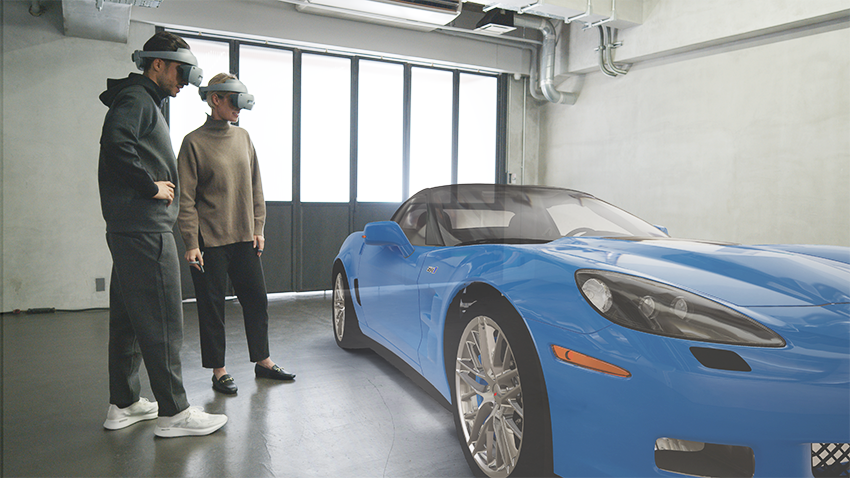
Immersive CAD for Industrial Metaverses
An exciting direction in the CAD area is the trends of recent years around the development of immersive solutions. With the help of 3D glasses or, by all means, ordinary computers or tablets, you can step directly into the 3D models to study, evaluate, change and share designs as desired. This type of solution is considered to be of great importance, not least in relation to the industrial metaverse, where different stakeholders in development teams can look at and work with the same model in real time.
Here, Frost & Sullivan highlights, for example, NX Immersive Explorer, which is a Siemens solution for immersive visualization and design review. In addition, as PLM&ERP News previously reported, Siemens has launched NX Immersive Designer, a solution developed in collaboration with Sony that leverages Sony’s XR head-mounted display, the SRH-S1, allowing users to directly manipulate and edit in virtual reality, visualize simulations in context to collect important feedback and reduce prototyping costs, and generate new collaboration opportunities.”
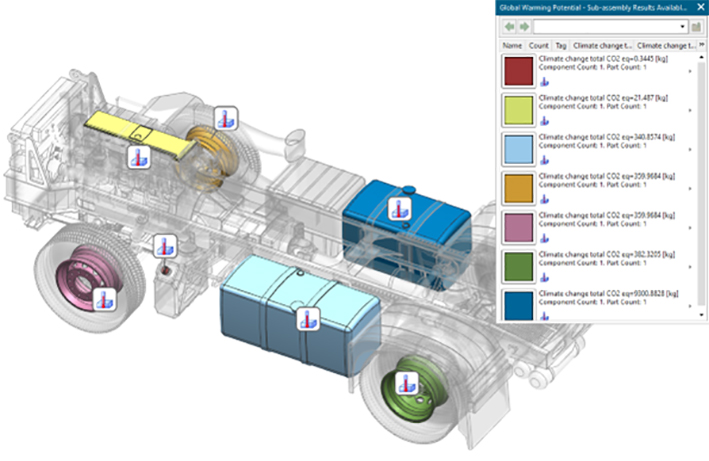
Modules for Sustainability-Related Design Work
Other trends of great importance in design work and product development in general are related to sustainability efforts. Frost & Sullivan notes that Siemens NX has solutions for this as well: the NX Sustainability Impact Analysis module. With this, users can perform sustainability calculations based on more than 30 environmental impact factors, what-if analyses and material selection optimizations. All powered by machine learning. Also notable is that, “the system leverages Siemens Digital Logistics to assess the impact on transportation-related carbon emissions and Teamcenter (the PLM platform) to establish environmental goals and requirements for design.”
Machine learning and AI are also elements that earn the company praise from an innovation perspective. Siemens has invested heavily in AI and generative design capabilities:
“NX Command Prediction has an AI-enabled user interface that can predict and provide commands based on user patterns, and NX’s generative design software has embedded topology optimization powered by convergent modeling technology,” the analyst writes in his assessment.
“Few CAD players have the same integrated breadth”
Overall, Frost & Sullivan’s assessment provides a verification of what has previously been widely known: Siemens has developed add-on modules and capabilities based on the exceptionally rich solution flora of the Xcelerator portfolio. Few players in the PLM market have the same integrated breadth across the product development and manufacturing areas, seen as a combined functional breadth. Software and add-on modules, “give manufacturers the ability to design parts that can be produced through additive manufacturing and the ability to create different types of performance-optimized lattice structures. In addition, other relevant modules are available for additional functions such as simulation, PCB design and model-based definition,” the analyst writes.
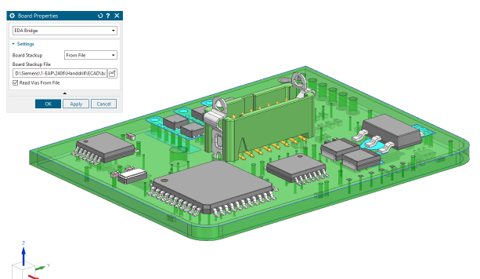
Overall, this gives Siemens a top rating on the innovation side: “Siemens has achieved the top rating in the innovation index and performed well in the growth index. Some of the company’s unique features include the many add-ons available to extend the capabilities of NX, its main CAD platform,” Frost & Sullivan summarizes its evaluation.

CIMdata: Full Compatibility in the Cloud
As mentioned in the introduction, here’s a brief look at PLM analyst CIMdata’s recent so-called ”Commentary”, this time about Siemens NX-X, the SaaS and cloud version on the CAD side.
CIMdata summarizes the background as follows:
”NX-X is part of Siemens Designcenter, a software suite that brings together its portfolio of design and engineering software including Solid Edge and NX into a unified offering so that companies of all sizes can design and collaborate using the industry-leading Parasolid modeling engine. NX-X is available immediately and complements NX. This delivery option provides mechanical CAD capabilities with full data model compatibility – meaning that the CAD models, drawings and other data produced in each can be opened directly and processed without migrating, updating or translating the CAD models.”
“Additional NX-X capabilities in the pipeline”
That said; what does CIMdata think of Siemens’ NX-X approach? Here’s how the analyst concludes the matter:
“NX-X in a SaaS delivery environment provides fundamental benefits, allowing NX CAD to be used in a flexible SaaS environment. The continuum of NX and NX-X provides a flexible and scalable CAD deployment option for companies’ diverse needs. Siemens has stated that NX-X will continue to expand with additional er capabilities from the Siemens portfolio, such as electrical design being integrated into the NX-X SaaS delivery model.”

One example of NX-X use that CIMdata cites is aircraft manufacturer Dovetail. Headquartered in Australia with operations in Spain, Dovetail is currently the only company in the world converting Cessna 208s to zero-emission battery power, and the only company to design a hydrogen-electric retrofit for the Beechcraft King Air, the most successful aircraft in its category. But how does NX-X fit in? CIMdata again:
“NX-X helps Dovetail develop these propulsion systems using seamless collaboration flows between teams based in Spain and Australia. While much has changed in the world of aviation, the basic structure of an aircraft has not changed much. Therefore, it is perfect for business and sustainability issues to rebuild capable aircraft with a new generation, zero-emission powertrain that takes a significant step towards cleaner air travel.”
NX-X is helping to do this. The need for digital software has increased as propulsion systems are designed. The ease of access in the cloud, worldwide availability facilitates and increases collaboration between design teams in Australia and Spain.
“It is at the core of Dovetail’s ability to deliver zero-emission air travel, while enabling aircraft operators to reduce operating costs by up to 40%,” said David Doral, CEO of Dovetail Electric Aviation.
CIMdata Recommends: “Take a look at NX-X”
NX-X can be deployed to and is suitable for use by organizations of all sizes. The token licensing model provides a level of flexibility that is very compelling for all companies, but especially those that need to manage their CAD resources more efficiently.
“The value of NX-X for companies of all sizes is clear. This value is monetary, but also manifests itself in convenience, flexibility and freedom of use. CIMdata recommends that companies consider the Siemens solution suite when evaluating and selecting CAD solutions…”
In upcoming articles, we’ll look at PTC’s Creo CAD and Onshape (cloud-based CAD), Dassault Systemes CATIA and SOLIDWORKS, and Autodesk’s AutoCAD, Inventor and Fusion (cloud platform).


